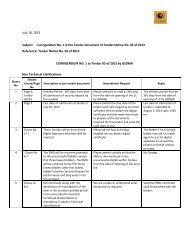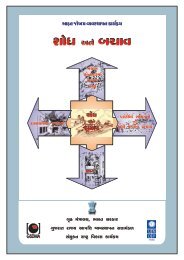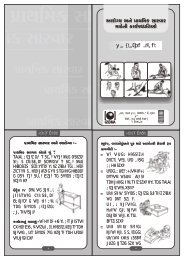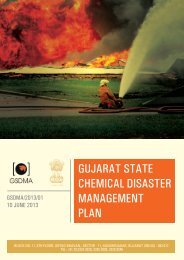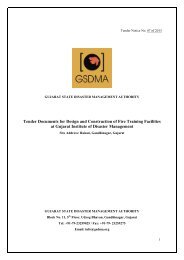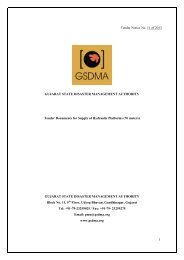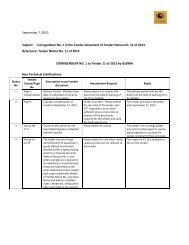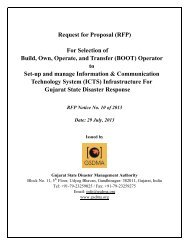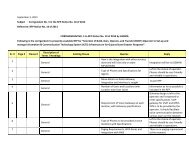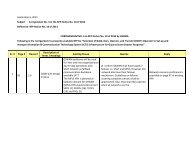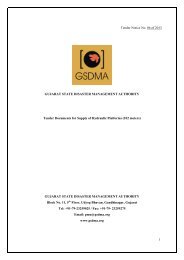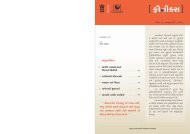Emergency Response Guidebook - Gujarat State Disaster ...
Emergency Response Guidebook - Gujarat State Disaster ...
Emergency Response Guidebook - Gujarat State Disaster ...
You also want an ePaper? Increase the reach of your titles
YUMPU automatically turns print PDFs into web optimized ePapers that Google loves.
GlossaryGlossaryControl zonesCryogenic liquidDangerous WaterReactive MaterialBCDArticles which are expected to mass detonate very soon afterfire reaches them.Substances or articles which may be readily ignited and burnviolently without necessarily exploding.Substances or articles which may mass detonate (with blastand/or fragment hazard) when exposed to fire.E&F Articles which may mass detonate in a fire.GHJKLNSSubstances and articles which may mass explode and give offsmoke or toxic gases.Articles which in a fire may eject hazardous projectiles anddense white smoke.Articles which may mass explode.Articles which in a fire may eject hazardous projectiles andtoxic gases.Substances and articles which present a special risk and couldbe activated by exposure to air or water.Articles which contain only extremely insensitive detonatingsubstances and demonstrate a negligible probability ofaccidental ignition or propagation.Packaged substances or articles which, if accidentallyinitiated, produce effects that are usually confined to theimmediate vicinity.Designated areas at dangerous goods incidents, based on safety andthe degree of hazard. Many terms are used to describe control zones;however, in this guidebook, these zones are defined as thehot/exclusion/red/restricted zone, warm/ contaminationr e d u c t i o n / y e l l o w / l i m i t e d a c c e s s z o n e , a n d c o l d /support/green/clean zone. (EPA Standard Operating SafetyGuidelines, OSHA 29 CFR 1910.120, NFPA 472)A refrigerated, liquefied gas that has a boiling point colder than -90oC(-130oF) at atmospheric pressure.Produces significant toxic gas when it comes in contact withwater.DecontaminationDry chemicalEdemaERPG(s)ERPG-1ERPG-2ERPG-3Flammable liquidThe removal of dangerous goods from personnel and equipment to theextent necessary to prevent potential adverse health effects. Alwaysavoid direct or indirect contact with dangerous goods; however, if contactoccurs, personnel should be decontaminated as soon as possible. Sincethe methods used to decontaminate personnel and equipment differfrom one chemical to another, contact the chemical manufacturer,through the agencies listed on the inside back cover, to determine theappropriate procedure. Contaminated clothing and equipment should beremoved after use and stored in a controlled area (warm/contaminationreduction/yellow/limited access zone) until cleanup procedures can beinitiated. In some cases, protective clothing and equipment cannot bedecontaminated and must be disposed of in a proper manner.A preparation designed for fighting fires involving flammable liquids,pyrophoric substances and electrical equipment. Common types containsodium bicarbonate or potassium bicarbonate.The accumulation of an excessive amount of watery fluid in cells andtissues. Pulmonary edema is an excessive buildup of water in the lungs,for instance, after inhalation of a gas that is corrosive to lung tissue.<strong>Emergency</strong> <strong>Response</strong> Planning Guideline(s). Values intended to provideestimates of concentration ranges above which one could reasonablyanticipate observing adverse health effects; see ERPG-1, ERPG-2 andERPG-3.The maximum airborne concentration below which it is believed nearlyall individuals could be exposed for up to 1 hour without experiencingmore than mild, transient adverse health effects or without perceiving aclearly defined objectionable odor.The maximum airborne concentration below which it is believed nearlyall individuals could be exposed for up to 1 hour without experiencing ordeveloping irreversible or other serious health effects or symptoms thatcould impair an individual’s ability to take protective action.The maximum airborne concentration below which it is believed nearlyall individuals could be exposed for up to 1 hour without experiencing ordeveloping life-threatening health effects.A liquid that has a flash point of 60oC (140oF) or lower.Decomposition productsProducts of a chemical or thermal break-down of a substance.Page 378Page 379



